 If you have problems with large tight rolls, there is a tool called the curling coach which is helpful, although with a little practice you can do them just using your fingers. I learned the technique of adding strips as I was rolling from Jane Jenkins. I was surprised at how easy it is. When I first started making large tight rolls, it was to make a chess set from a kit. This was probably 25 years ago. It was suggested to glue the strips end to end. I can’t even tell you how much harder that was. I would get six or seven strips rolled and somehow loosen my grip on the whole thing and end up with a twelve foot tendril! Try rolling that up again! Sliding the strips in as you roll makes the whole process so much easier and the resulting coil is nice and smooth, not lumpy.
If you have problems with large tight rolls, there is a tool called the curling coach which is helpful, although with a little practice you can do them just using your fingers. I learned the technique of adding strips as I was rolling from Jane Jenkins. I was surprised at how easy it is. When I first started making large tight rolls, it was to make a chess set from a kit. This was probably 25 years ago. It was suggested to glue the strips end to end. I can’t even tell you how much harder that was. I would get six or seven strips rolled and somehow loosen my grip on the whole thing and end up with a twelve foot tendril! Try rolling that up again! Sliding the strips in as you roll makes the whole process so much easier and the resulting coil is nice and smooth, not lumpy.Friday, December 18, 2009
Last Minute Quilling - Quilled Trinket Boxes
 If you have problems with large tight rolls, there is a tool called the curling coach which is helpful, although with a little practice you can do them just using your fingers. I learned the technique of adding strips as I was rolling from Jane Jenkins. I was surprised at how easy it is. When I first started making large tight rolls, it was to make a chess set from a kit. This was probably 25 years ago. It was suggested to glue the strips end to end. I can’t even tell you how much harder that was. I would get six or seven strips rolled and somehow loosen my grip on the whole thing and end up with a twelve foot tendril! Try rolling that up again! Sliding the strips in as you roll makes the whole process so much easier and the resulting coil is nice and smooth, not lumpy.
If you have problems with large tight rolls, there is a tool called the curling coach which is helpful, although with a little practice you can do them just using your fingers. I learned the technique of adding strips as I was rolling from Jane Jenkins. I was surprised at how easy it is. When I first started making large tight rolls, it was to make a chess set from a kit. This was probably 25 years ago. It was suggested to glue the strips end to end. I can’t even tell you how much harder that was. I would get six or seven strips rolled and somehow loosen my grip on the whole thing and end up with a twelve foot tendril! Try rolling that up again! Sliding the strips in as you roll makes the whole process so much easier and the resulting coil is nice and smooth, not lumpy.Thursday, December 10, 2009
Pat's Quilled 3D Christmas Tree & "Pattern"
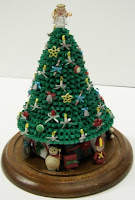
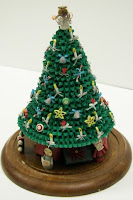
 trees because the greens didn’t match. YUK!) The tree is very simple to make. I started with a 4” circle cut from card stock for the base; I would normally use a dark color for the base but have started one on a white base to make it easier to see. My first row of quills was 6” teardrops which I glued (pointy side out) around the circumference of the base. My next row was 3” tight rolls which are glued on top (toward the back) of the teardrops. The rest is easy . . . just keep alternating rows of
trees because the greens didn’t match. YUK!) The tree is very simple to make. I started with a 4” circle cut from card stock for the base; I would normally use a dark color for the base but have started one on a white base to make it easier to see. My first row of quills was 6” teardrops which I glued (pointy side out) around the circumference of the base. My next row was 3” tight rolls which are glued on top (toward the back) of the teardrops. The rest is easy . . . just keep alternating rows of 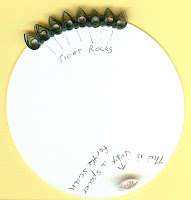 teardrops and tight rolls. Each row is glued farther back than the one before; the shape of the tree just comes naturally. You can make the tree in any size; mine are usually about 6” high. If you want a smaller tree, start with a smaller circle; for a larger tree use a bigger circle. The tree “trunk” is tight rolls (I use at four full strips to make them sturdy) stacked and glued together. You can make these with 3/8” strips so you don’t have to stack so many. Glue the “trunk” to the middle of the card stock base and then glue to whatever you are using for the base of the finished piece. (Mine is on a wood base that came with a glass dome.) I made my trunk about 1 ¾” high because I put little paper packages and quilled figures under the tree. The fun part is decorating the tree. I made lots of tiny bows from 1/16” wide paper. The candles are tight rolls made from ¼” paper strips about 1/12” long. Glue a bow to the
teardrops and tight rolls. Each row is glued farther back than the one before; the shape of the tree just comes naturally. You can make the tree in any size; mine are usually about 6” high. If you want a smaller tree, start with a smaller circle; for a larger tree use a bigger circle. The tree “trunk” is tight rolls (I use at four full strips to make them sturdy) stacked and glued together. You can make these with 3/8” strips so you don’t have to stack so many. Glue the “trunk” to the middle of the card stock base and then glue to whatever you are using for the base of the finished piece. (Mine is on a wood base that came with a glass dome.) I made my trunk about 1 ¾” high because I put little paper packages and quilled figures under the tree. The fun part is decorating the tree. I made lots of tiny bows from 1/16” wide paper. The candles are tight rolls made from ¼” paper strips about 1/12” long. Glue a bow to the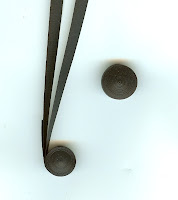 candle base and put a 1” shaped teardrop for the flame. I use 12” strips to make little bells from silver paper (the new metallics are much prettier than what I used) and glue a bow to the top and a matching “clapper” inside. I also added some little yellow stars (using 5 one inch teardrops), Christmas balls (using 18” of paper is different colors), folded roses, and made red and white candy sticks by twisting the two colors into tendrils. This is my favorite type of tree, although I have also made some Victorian trees and decorated them with fans, hearts, roses, candles, and bells. Hmmm . . . maybe it’s time for new tree!
candle base and put a 1” shaped teardrop for the flame. I use 12” strips to make little bells from silver paper (the new metallics are much prettier than what I used) and glue a bow to the top and a matching “clapper” inside. I also added some little yellow stars (using 5 one inch teardrops), Christmas balls (using 18” of paper is different colors), folded roses, and made red and white candy sticks by twisting the two colors into tendrils. This is my favorite type of tree, although I have also made some Victorian trees and decorated them with fans, hearts, roses, candles, and bells. Hmmm . . . maybe it’s time for new tree!Wednesday, November 25, 2009
Happy Thanksgiving!
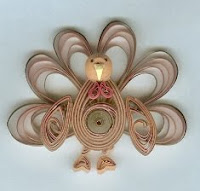 Happy Thanksgiving!
Happy Thanksgiving!I hope your Thanksgiving is filled with family, friends, and of course, lots of good food. It is my favorite holiday; a day spent with those we love without all of the “hoopla” of some of the other holidays. This year I have been reflecting about the special people in my life. My children, who are my biggest fans; my husband, who willingly shares his home with “Whimsiquills”, (it’s not a very big house!); Debbie, without whom I couldn’t run the business and of course our friends and families. But I am also thinking about the quillers I have met over the years and how they have changed my life. Malinda Johnston, (former owner of Lake City Crafts) has been a kind of mentor over the years. She encouraged me to start selling supplies, published some of my work in her books, and still stays in touch even though she has retired and moved on. I am grateful for a special group of quillers (Mary Alice, Ev, Donna, Bobbye, Kay, Gerta, Rita, Rick, Jinny, and Malinda), who were, and still are, so dedicated to this beautiful art form that they formed the North American Quilling Guild so American quillers have a way to stay in touch and learn from each other. I am thankful for my friend Andy Papineau (Paplin Products) who has worked so closely with us here at Whimsiquills. He has worked with us to develop tools (like fringers and crimpers) that were truly scarce just a few short years ago, and he has brought in all of the colors I’ve asked for as well as specialty papers. He also prods me to keep working on new quilling kits, which I never would have done on my own. I am also grateful to countless numbers of quillers, many of whom I have never met, who have written to me over the years, sending pictures of their work as well as those who have let me feature them is this blog. I have a great deal to be thankful for; I get to work at something I love and I enjoy all of the quillers I work with. I wish you all a Happy Thanksgiving and a happy healthy holiday season.
Monday, November 9, 2009
Quilling Can Be Therapeutic

Directions for snowflake card: (in case you are interested)
I used the new Snow Bubbles punch on a white Paplin fold over greeting card. I then cut a 3’x4” rectangle from an accessory pack and used the border punch. I attached it to the front of the cart using a Dotto removable adhesive (so I could reposition it if necessary. I found the center of the punched rectangle by measuring diagonally across the rectangle. The snowflake was made from six 6” marquises which I glued into six 4” open V’s. I then made six 2” teardrops and assembled the snowflake right on the card. The tiny snowflakes in the corners were the “falls” from the punch. Quick and easy.
 Directions for Christmas ornament:
Directions for Christmas ornament:I used the Antique Elegance Circle Border Punch for the green background, positioned it the red card with Dotto removable adhesive. Then I positioned a white circle die cut (2 ¼”) on the punched background. I marked the center of the die cut and put a green 3” tight roll in the center. I placed six 3” tight rolls around the center. I made six green 3’ teardrops which I alternated with six 3” marquises around the tight rolls. For the border around the die cut I used eighteen 3” marquises and eighteen green 3” tight rolls between the marquises.
Monday, October 5, 2009
Meet Alise!
“My name is Alise and I am 15 years old. I’ve been quilling for 5 years. I contacted you about how you quilled the teacup on your website and you gave me wonderful instructions. I added some sugar cubes and candy. I entered in our local fair and won a blue ribbon. I made a Christmas Faberge Egg for this year’s fair. I enclosed a picture of these projects and a framed picture that I also made.”
Of course I was delighted to see her work as you will be. I wrote back and asked permission to show her work on my blog and to get a little more information from her.
 “I am fifteen years old, in the tenth grade and from Lynn, MA. I began quilling in the fifth grade after taking a class that was being offered at a local Michael’s store. I only know basic quilling but with that I found you can do so much. I’ve given many quilled gifts at Christmas and to my teachers. For the past four summers, during vacation, I’ve challenged myself to do bigger quilled pieces for our local agricultural fair – the Topsfield Fair and I have happily won four blue ribbons. I like to embellish my pieces with pearls, beads and especially Australian crystal rhinestones. The tea cup and saucer that was displayed on your website was my first attempt at a three dimensional piece. Although it was very challenging, I really loved the finished product. Besides quilling, I like to knit, play tennis and play my violin.”
“I am fifteen years old, in the tenth grade and from Lynn, MA. I began quilling in the fifth grade after taking a class that was being offered at a local Michael’s store. I only know basic quilling but with that I found you can do so much. I’ve given many quilled gifts at Christmas and to my teachers. For the past four summers, during vacation, I’ve challenged myself to do bigger quilled pieces for our local agricultural fair – the Topsfield Fair and I have happily won four blue ribbons. I like to embellish my pieces with pearls, beads and especially Australian crystal rhinestones. The tea cup and saucer that was displayed on your website was my first attempt at a three dimensional piece. Although it was very challenging, I really loved the finished product. Besides quilling, I like to knit, play tennis and play my violin.” 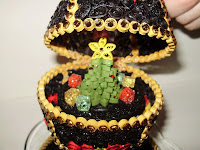

In this age of “instant gratification” it is truly refreshing to see a young person willing to take the time to create. Thank goodness we have Alise to carry on our beautiful art.
Friday, September 25, 2009
Quilling with the Visually Impaired & Evangeline (Part 2)
I also spoke with a quilling friend of mine who is legally blind, and who had put her quilling away when she lost her sight. When I told her about Evangeline’s classes, she decided to give it a try, once again. I will let you know how she makes out. We talked about the necessity for good organization for the blind . . . for those of us who are blessed with sight; we can have a messy workspace and just pick out the appropriate color strip from the pile on our tabletop. Perhaps organizing strips by color could be done by using the label makers available in office supply stores to label the front of plastic drawers or the top of the bags the strips come in. Once again, I am open for any suggestions.
Friday, September 18, 2009
Quilling Tool Lending Program/Quilling Teachers

We have come up with a program that I think is pretty unique, a lending program. When I talk to a scout leader or teacher who is planning to teach a group to quill . . . I tell them about our tool lending program. Most of these groups have a very limited budget (if any at all), so we send them the tools they need for their class at no charge, along with some other goodies (sometimes bookmarks or mat boards, whatever we have on hand). We also make sure they have links to our free patterns and instructional sheets which include things like a basic shapes chart and are all free and downloadable. We also encourage them to visit our blog http://www.quillingwithwhimsiquills.blogspot.com/ where we have all kinds of helpful info like teaching quilling. We have had an excellent response to this program.
Friday, September 4, 2009
Meeting Fellow Quillers in the Stranger Sitting Next To You
BTW I do have a page on Facebook and I have started a quillers group as well.
Friday, August 28, 2009
Quilling in Magazines
My quilling friend, Malinda Johnston, (yes that Malinda Johnston, the one who authored so many quilling books and founded Lake City Crafts) gave me a call after she came back from her trip to Paris. While in France she took a side trip to the Netherlands to visit her friend Trees Tra, who is also a quiller. (Some of you may have some of Trees Tra’s quilling books.) At any rate, she gave Malinda a copy of a Dutch women’s magazine called Libelle. The cover of the magazine shown here was covered with a delightful quilled design. Malinda was kind enough to send me the magazine; not only was there quilling on the cover but many of the article titles were done in quilling. If the whole title wasn’t quilled the capital letters were. While I am sure copy write laws would prohibit showing you all of these pages, I can tell you they were awesome. An article about Club Tropicana had the letters CLUB quilled with tropical palm trees coming out of the letters. What a boost for the art of quilling! The style looked kind of familiar to me; I went through the magazine to see if the artist was listed. When I couldn’t find any reference to her, I emailed the magazine to inquire who the artist was. (I used the Google translator since my knowledge of the Dutch language is non-existent. I can read some German and was able to get the general idea of some of the articles, but certainly couldn’t make an inquiry in anything other than English. Isn’t the internet awesome?) I did get a reply, and as I expected the artist was Yulia Brodskaya. I am sure many of you have heard of her, her work has been the subject of many quilling blogs. Her web site says “Yulia Brodskaya was born in Russia (Moscow); prior to moving to the UK in 2004 she was interested in diverse creative practices ranging from Textile Painting, Origami and Collage to more traditional Fine Art practices. Following an MA in Graphic Communication (2006, University of Hertfordshire) she has continued to experiment and explore ways of bringing together all the things she likes most: typography, paper, and highly detailed hand-made craft objects.” Here is a link to her web site http://www.artyulia.com/ When you get there click on Illustration and then PAPERgraphic to see some of her awesome work.

Friday, August 21, 2009
Quilling with Allen Girvin
Friday, August 7, 2009
Evangeline Enns & Quilling with the Blind
Several weeks ago I did a blog about teaching quilling to the visually impaired. Lots of responses and suggestions came in which I have not had time to compile. However, I did make copies of everything you all sent and forwarded them to Evangeline Enns, the Canadian quiller who is taking on this project. I am posting the letter she sent to me regarding all of your hints and tips. I will post some of the suggestions at a later date.
For Pat Caputo from Evangeline Enns RE: Teaching the blind to Quill.
Thanks to all who blogged & gave me the encouragement I needed. It arrived just in time too…the (C.N.I.B.) Canadian National Institute for the Blind; Edmonton chapter has a very good activity director who wants to add quilling to her array of classes given. Each of your notes had good ideas for me & I now feel it is possible. I feel that the people I will be working with have capabilities that will solve my questions as we go along.
I have quilled for 25 years. I started using an opened out paper clip. The knurled edge helped keep the paper in place. I discovered the tool only to be told by the English when I showed a piece in the England in the 90’s that I must go without it. I now do what each piece needs. I did not know until I read Dorah’s blog that I was rolling tool without watching or seeing through fingers and had been for years. Now I’m paying attention to what I feel as I use my tool.
I lay the paper flat between my left thumb and index finger. The paper is completely covered. With my right hand holding the tool, slide it on to the paper by wiggling the tool. When it is on, the thumb can be a “wall” to wiggle to, and then roll. Don’t forget to use your finger nail to prepare paper first.
Our first meeting in September will cover marquises, for a flower, a tight circle for the center, a couple of flowers and stems using ¼” strips. The activity director is going to shadow box each one so they will feel successful. This lady is quite sure this is possible, after she made a simple fridge magnet. She knows her people and their capabilities. As you know a flower in a box has more class than a fridge magnet with the same flower. At the end of the day I will probably be in shock.
After this we’ll know who are really interested in starting to learn the basics and make a sampler. I can show the way but they will show me how it can be done one class at a time.
Thank you so much for your encouragement. Keep in touch.
Evangeline Enns
Thursday, July 23, 2009
Quilled Table Decorations
PS - I will do part 2 of Quilling for the Blind as soon as I get all of the comments you sent compiled.
Wednesday, July 1, 2009
Quilling for the blind?
Making some of the various shapes and then letting the student “feel” the shapes is a possible way of demonstrating the kinds of shapes that can be made. It would seem to me that finger rolling would be the best way to go rather than trying to “thread “a slotted tool. I am also thinking that starting with wider strips might make sense since the pieces would be larger and perhaps easier to handle. Of course you wouldn’t be able to “show” this technique, but by feeling a straight strip, and then explaining that the strip should be run over the fingernail to “soften” it and start it curling. Once the curl at the tip is started, it is fairly simple to continue to roll the strip into a loose coil. I would suggest using a fine tip glue bottle to glue the end of the strip down so the glue can be placed exactly where it is needed. (I find the glue bottle less messy than working with a toothpick and spot of glue). Once rolled and glued it would be fairly simple to pinch the coil into the desired shape.
Then we have the issue of colors etc. Many sighted quiller store their strips in the original packaging, If the packages were marked in Braille it would be helpful in keeping colors organized. My thought would be to put finished shapes into something like the cups of a styrofoam egg carton. The edges of the cups could be marked in Braille with the color and shapes. Another option would be to store shapes in small strips in the plastic chests used to store nuts and bolts etc. That is how I store my quilled flowers, small strips and extra shapes. I do organize them by color and either have a small strip of the color or the name of the color taped to the front of the drawer, again this could be marked in Braille. As I think about it, I think the chests might work better than the egg carton idea; they wouldn’t get knocked over or tipped as easily.
When it comes to actual designs, I am kind of stumped. Perhaps letting the students feel some different designs would give them some ideas. Arranging pieces would be determined by feeling the shapes. These were just a few of my thoughts. I think a blind quiller would have to be much better organized than I am. (No piles of bits of strips and shapes like there are on my work table) It is a challenging question. I would love to hear your thoughts and will be happy to share them in a future post. You can comment on the blog or email me directly at Whimsiquills@cox.net
Friday, June 19, 2009
Differences in Quilling Papers/Strips - Updated
A frequently asked question, especially from new quillers, concerns the differences in quilling strips. How are English strips different from American strips etc? Probably, the most obvious difference is in the length of the strips. In the 1970's, 24" was the standard length for quilling strips. That is no longer the case. Lake City papers are 24” long with the exception of their watercolors, which are 12". Paplin papers, another American paper, are generally 23" long, their graduated and two toned strips (which by the way are actually “printed”) are 12” long. Quilled Creations, another American company, strips are about 18" long; their graduated papers are about 12" long. English strips are about 17” long with graduated strips coming in at 12”. The English also have some wonderful novelty (specialty) papers such as graduated strips where the colors darkens as it goes up the strip, dark center strips which go from white to color to white again, two – toned papers which have different colors on each side of the papers, pearlized on edge papers, & holofoil and gilded edged papers which are absolutely beautiful. Not to be “outdone”, the American companies (Paplin and Lake City) have both come out with lines of pearlized and metallic papers, which have a pearlized or metallic finish on both sides of the strips. Paplin has some beautiful pastel pearlized colors, and both companies have some very rich “jewel toned” metallic’s, deep green, blue, and a deep wine color. I have used these papers for some very special effects. I recommend that you use tacky glue on these strips as they have a different finish (almost slippery) than standard strips.
Both papers (American & English) work well together although with today’s economy and with the difference between the dollar and the British pound the English strips are more expensive. We continue to bring in English colors that are not available here in the states. The weights of the different papers vary, some of the darker colors are a heavier weight (I have been told that the heavier weight has something to do with being able to take the darker dye, although the Paplin black is a nice easy weight to work with). Specialty papers, like parchment, tend to be a lighter weight. Some of the "quilling" paper sold in scrapbooking stores, (especially the tube paper sold as "quillstix") is very heavy, almost as heavy as cardstock. Unfortunately, some members of the scrapbooking community are saying this is the only weight that will hold up in a scrapbook. Those of us who have been quilling for a while know that this is not accurate. Regular quilling paper is incredibly strong when rolled and placed on edge. Since we carry so many different kinds of papers here at Whimsiquills, I have tried them all. I don't like working with the heavy "card stock" like papers, and find them difficult to finger roll without getting unwanted creases. If I have to roll a heavier paper, I generally use a tool to keep tension even.
All of the choices now available can cause some confusion for new quillers. I find that all of the papers can work pretty well together if you are just careful to measure the strips you cut from the different brands. For example: if you are using an English yellow for the center of a flower, but an American orchid for the petals, you will want to start out with the same length strips. If you are using a heavier weight paper for a flower center, you will either have to make the strip a little shorter to compensate for the larger size center, or perhaps make a couple of extra petals for your flower.
In some English kits and books, directions are given as using 1/4, 1/8 of a strip. Obviously, if you are using papers of different lengths, you will have to go back to the tried and true method of measuring out your strips. I hope this has answered some of the questions about the many papers available.
Here is an added note of interest for those of you who might be combining quilling with card making or scrapbooking. Paplin offer every one of its colors in 8 ½ x 11 sheets and will do special cuts ½”, or 1” strips to be used for punched flowers/leaves or borders. They also offer a line of color greeting cards which match some of their most popular colors.
Thursday, June 11, 2009
Quilling with Rick Whitman
When I agreed to coordinate the first Accord Quilling Calendar (1997), I had a little trouble getting quillers to participate; some felt they couldn’t create small, “simple’ designs that could be included in the calendar/kit. Rick came up with 27 designs including a horse drawn sleigh,

garden tools,

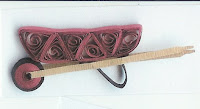





Her designs for the 2008 calendar (N2008) were also outstanding. I’ve included just a few of the pictures here.



When Accord decided not to publish the 2009 calendar, we were all disappointed. Rick had done some adorable nursery rhyme characters. Since they weren’t going to be used for the calendar she had to figure out a way to use them. She used that great imagination again. Here is what she did with them. She told me her nephew helped her with the computer generated backgrounds; these are the pieces she brought to display at this year’s NAQGCON. (North American Quilling Guild Conference 2009)
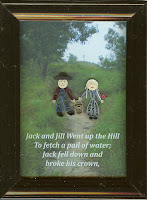






Friday, May 29, 2009
Quilling with Delphene



“I started quilling at the age of 8 or 10. My sister had won a craft kit at a Saint Nicholas (November 5th) feast given by the Dutch embassy in Paris. This kit included a simple quilling pattern with a few strips of paper, since she took no interest in it, I finally made it. It was flowers with a bird. Though it looks quite awful, I really enjoyed making it and was proud of it at that time. I always kept it as a reminder, but it is somewhere in a box in France and I don't have a picture of it to show you.
Anyway, from that moment, I never stopped quilling. I was lucky to have an aunt in the Netherlands who was loved crafts (she even worked later in a craft shop) and though she never enjoyed quilling herself, she helped me purchase the paper strips and my first books (I was also lucky that quilling was in at the moment in the Netherlands, because it is now almost impossible to find any quilling supplies and there was no internet then). In the first years I mostly made cards for birthdays, Christmas... following the patterns. When I mastered the basic shapes, the flowers.... I made bigger patterns still following the books. I actually made all the patterns from Malinda Johnson book: Decoratief Papierfiligraan (in Dutch): the panda, the alphabets... which is my very favorite book.



At that time, I had less time with my study and my job, and became bored by the book patterns. So when I had more time during a holiday, 5 years ago maybe, I made my first personal designs. From that moment I kept receiving orders from friends and family, since I told them that you can do everything in quilling, and it is always a new challenge. I also sold a few of my creations in a shop in Paris owned by a guy who made the most amazing origami lamps I've ever seen. Since he had to close the shop (he's now selling on internet) and I was to move to the US anyway I had the idea to create my website: in English and Dutch to make contact with other quillers, in French to promote quilling in France where it is completely unknown. I never took pictures of my creations before I started selling them. And when I created my website I have been asking around for pictures of the quilling I have given away, and most of them are now in my picture gallery, there are just a few creations missing.
I make flowers and frames when I am asked for them, but they are not my favorite (I might have made too many of them earlier!). I enjoy making designs who are the main object of decoration. I tried modern techniques like 3D and husking, but I have a preference for traditional quilling. I use almost no tools, and I coil the strips with my fingers; I used to work with 3 mm strips, but I now often use smaller ones.



I like using the traditional basic shapes in a new context. I particularly enjoyed making the umbrella, and I am currently making lampshades in the same way. I also like making fantastic animals, working on the shapes and colors, the eye expressions. My lingerie designs have a huge success, and I intend to make a whole collection. I have a lot of other projects, and my problem is not a lack of inspiration but a lack of time!!
After high school I studied law, and worked as a student in kitchens. After a few years I decided to turn myself to bakery and pastry; Though I do love my job as a pastry cook, I really envy you for being able to quill full time; and I would love to teach quilling because the persons I tried to interest in it never had the required patience for quilling! . I will love to have some feedback from anyone who visits my site.”






